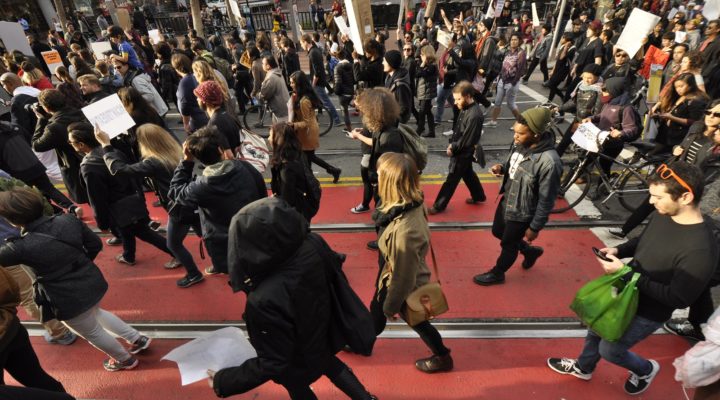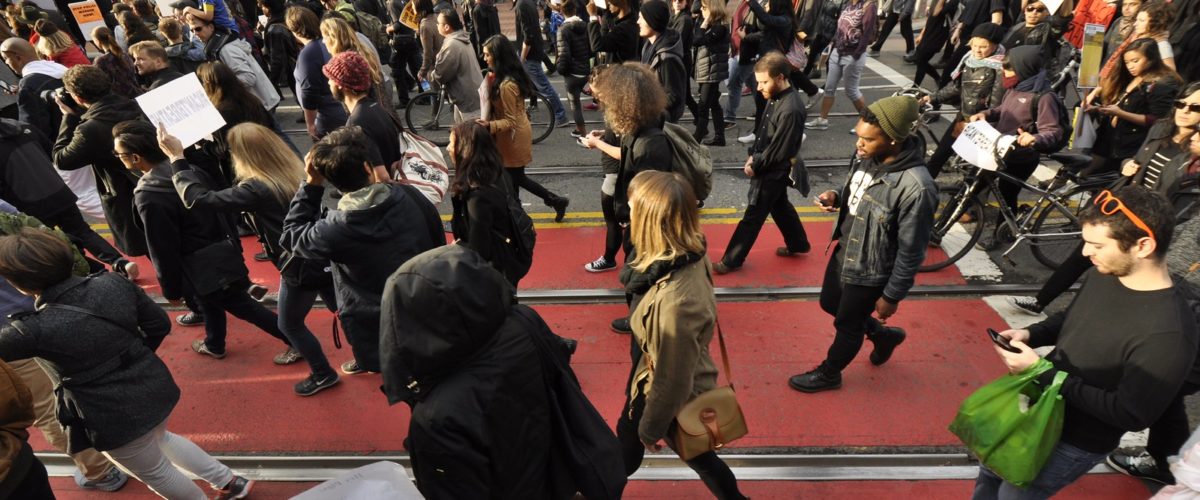Jonathan Redding is a Baptist minister from North Carolina who teaches apocalyptic literature at a Methodist university in Lincoln, Neb.
But arguably the most unusual aspect of his ministry is a calling to serve as a chaplain at Black Lives Matter protests — a role that sometimes involves standing between protesters and counter-protesters.

Jonathan Redding at a 2017 demonstration at an ICE facility in Tennessee.
“Everybody has different gifts,” explained Redding, an assistant professor of religion at Nebraska Wesleyan University. “One of my gifts is I’m a bigger guy at 6’2, 220 and with a voice that is commanding. I feel like one of the things I can do is be a big-but-calm presence so other people can do their thing.”
Redding, a 2012 Wake Forest School of Divinity graduate, has been participating since 2015 in what has become known as “movement chaplaincy,” in which clergy seek to provide a calming presence at demonstrations. Their presence is often welcomed by authorities and movement organizers alike.
Ministers usually wear stoles and sometimes religious collars to announce their presence. “If someone punches a priest or a pastor, that is going to look really bad,” he said. “One of the things I can do is use my white privilege and size to help other people feel safe.”
Redding spoke with Baptist News Global about movement chaplaincy and its contribution to peace and justice.
Some call it “movement chaplaincy.” What language do you use to describe this form of ministry?
I think “movement chaplaincy” is good. The language we have used around here is “pastoral presence” or “local minister presence.” But I think movement chaplaincy is accurate.
Is it chaplaincy in the sense of providing a non-anxious presence?
Yes, that’s what we are trying to do. We are all trying to provide a presence that makes the protesters feel safer and makes the cops feel safer. It’s an effort to contribute to seeing that things go peaceably.
When did you first attend a protest event in this way?
It was in 2015 in Nashville. A Vanderbilt (University) law professor, Carol Swain, made some anti-Muslim comments. There were some protests, so I showed up for those. That was the first time I attended something like that wearing my stole.
Is there anything more to the stoles than providing a visible presence?
The stole is there to be seen and for protection. If things get violent, I want there to be an outward expression of my religious affiliation. If there was a situation in which I was being arrested, I want them to know who they are arresting. And I am trying to keep things stable just by being there.
Do younger generations of people even know what a stole is?
Yes, people know what it means. And mine is white with gold crosses, so it’s pretty clear.
Is there ever any pushback to your presence?
It’s always warm, always positive. I have never gotten any pushback.
Is your role formal? Are you invited to be at these events?
Here in Lincoln there is a group of us who go together at the invitation of local Black Lives Matters leaders. They reach out to us. We only wear the stoles when we are asked to come because we know that Christians have a history of going where they are not invited and causing harm. We only wear outward signs of our faith when we are asked to be there.
Are you credentialed by law enforcement?
No, there is nothing like that and that’s not something I would want because I am staunchly in favor of separation of church and state.
What do you and other clergy do during a march or protest?
We basically provide a perimeter. We mark the boundaries without having to use police tape or organizers having to take time away from being in the march. They don’t have to worry about what’s going on at the edges. We also keep our eyes open for people who look suspicious. Basically, it’s like edge control but in a way that is more inviting.
Do you and other ministers get much feedback after these events?
Black Lives Matter leaders always thank us for being there and they tell us people feel safe because we are there. And the contact person for the police department has told the leaders of the movement they have appreciated our presence. We are not there for any agenda other than what people ask of us in the moment. We are there to make people feel safe to express their powerful emotions in a way that is constitutional and does not seek to hurt or harm anyone.
Do you ever organize vigils or prayer sessions during the marches?
I have not, but I know others have. Earlier this year I was going to go to Lincoln’s first-ever Pride march. I was going to go with a sign that said something like, “Have a pastor bless you.” But Pride got canceled due to COVID-19. All of this is important to me because the Christians in America who get the most TV time are the loud and obnoxious ones who cause harm, and they do not represent the majority of clergy out there. Instead of yelling at people we want to have a kind, calming presence.
Have you ever felt threatened while performing this ministry of presence?
There was a march through a neighborhood that was affluent. There was one guy on his corner with a “Trump 2020” sign saying “f— you” and “get out of our neighborhood.” So, I went and stood between him and those who were marching so they could just keep walking by. That was closest anything has come to getting ugly.
How does it feel to be involved in this kind of ministry?
It can be a rush, but it is what we are here for. We are called to be the people of God, not the people of complacency. Whether it is visiting people when they are sick in the hospital or it is providing boundary security when there’s a march, then that’s what we are called to do.


